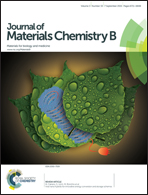A laminin mimetic peptide SIKVAV-conjugated chitosan hydrogel promoting wound healing by enhancing angiogenesis, re-epithelialization and collagen deposition†
Abstract
Angiogenesis and re-epithelialization are critical factors in skin wound healing. Growth factors and stem cells have demonstrated their active roles in promoting these two processes. Peptides show similar effects with growth factors with lower cost and controllable properties. Here we report a biomimetic fragment of the laminin –Ser-Ile-Lys-Val-Ala-Val (SIKVAV)-conjugated chitosan hydrogel that can promote skin regeneration. In vitro we found that this peptide-conjugated hydrogel significantly promoted BMSC adhesion and proliferation. In vivo, this hydrogel accelerated wound contraction. The subcutaneous implantation test and H&E staining results revealed that the peptide-modified chitosan hydrogel dramatically led to the formation of new blood vessels. Moreover, Masson staining showed that many newborn collagen fibers appeared in the peptide hydrogel group, while only a few newborn collagen fibers were found in control and chitosan hydrogel groups. The peptide chitosan hydrogel also re-epithelialized quickly, while the control and chitosan hydrogel took more time to complete. These results suggest that the SIKVAV peptide is an effective motif to significantly improve the function of chitosan in angiogenesis and re-epithelialization of skin.


 Please wait while we load your content...
Please wait while we load your content...